Mastering Chicken Dopiaza: An Authentic Indian Curry at Home
Are you a devoted fan of the rich, aromatic curries served in British Indian Restaurants (BIRs)? Does the thought of a perfectly balanced Chicken Dopiaza transport you to your favorite curry house? Get ready to bring that coveted restaurant experience directly into your own kitchen!
This comprehensive guide and step-by-step recipe will unlock the secrets to preparing an exquisite Chicken Dopiaza. We’ll demystify this incredibly popular Indian curry, allowing you to recreate its authentic flavors and textures with confidence, right in your home kitchen.
The name “Dopiaza” itself holds the key to its unique character. Derived from Persian, it literally translates to ‘two onions’. Breaking it down further, ‘do’ means two or twice, and ‘pyaza’ signifies onions. This isn’t just a whimsical name; it’s a fundamental principle of the dish.
Essentially, onions play a dual and crucial role, entering the cooking process at two distinct stages and undergoing two different treatments. This double dose of onion is what defines Dopiaza, creating a depth of flavor that is truly unparalleled.
Yes, Dopiaza is unapologetically onion-heavy, and that’s precisely its charm! The slow caramelization of one batch of onions contributes a beautiful, subtle sweetness and a deep umami base, while the addition of another batch of flash-fried, slightly charred onions at the end provides a contrasting texture and a fresh, vibrant onion bite. This intricate interplay of sweet, savory, and aromatic notes has firmly established Dopiaza as a beloved classic Indian dish.
While our traditional Dopiaza recipe leans towards the milder side spice-wise, catering to a broad palate, we’ve included plenty of suggestions to effortlessly crank up the heat. So, whether you prefer a gentle warmth or a fiery kick, you can customize your curry to perfection.
It’s true, crafting an authentic Dopiaza might involve a few more steps and a touch more patience compared to a quick Chicken Tikka Masala. However, we promise that the deeply satisfying and undeniably delicious end result is absolutely worth every bit of effort! The layered flavors and tender chicken will impress even the most discerning curry connoisseurs.
Fret not about complexity! We’ve meticulously designed this guide with straightforward, step-by-step instructions, accompanied by clear photos. These visual aids make understanding and executing each stage of the Dopiaza cooking process a complete breeze, ensuring your culinary adventure is both enjoyable and successful.
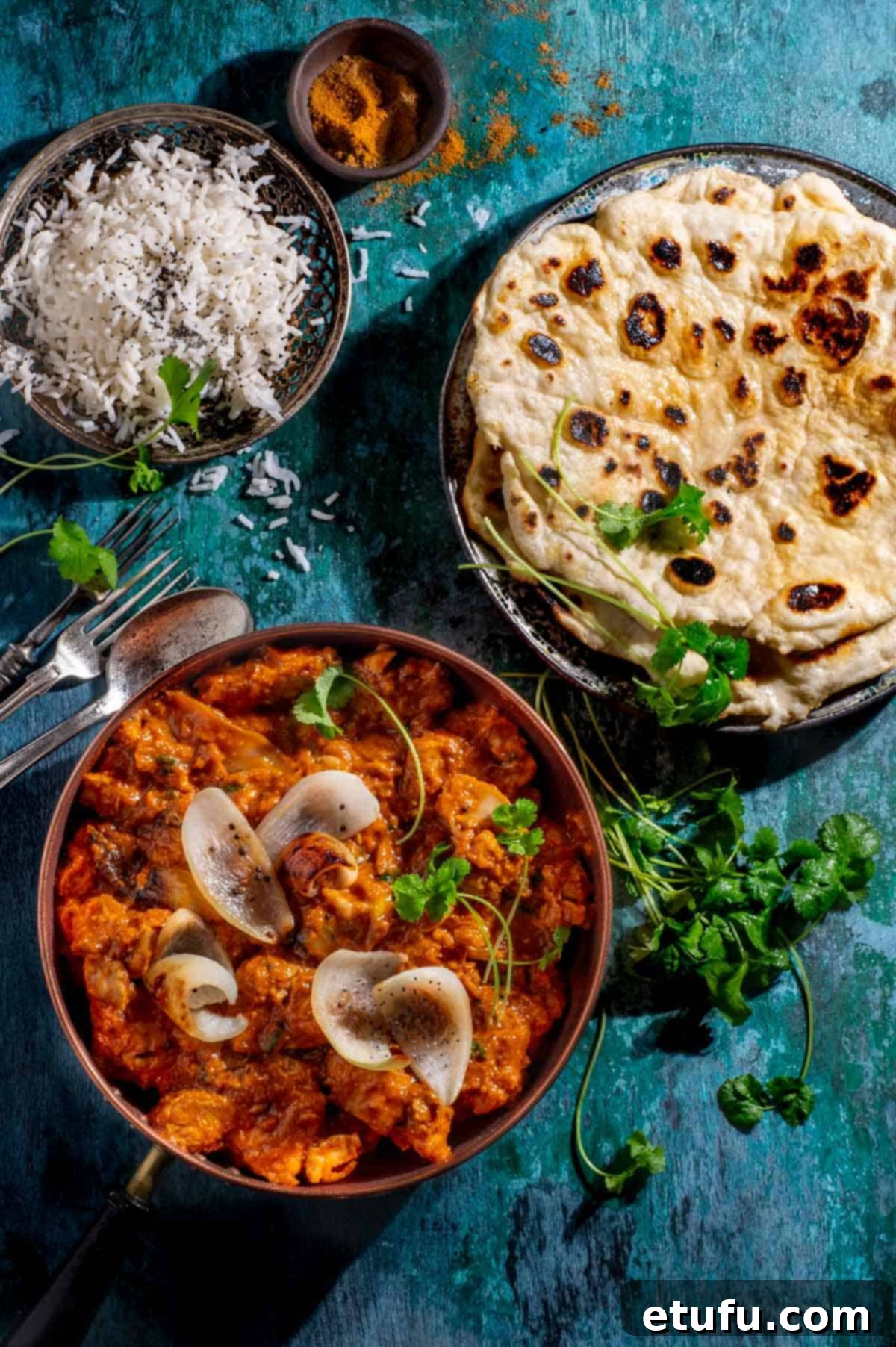
Fast Facts – India: A Culinary Powerhouse
India, a land of vibrant cultures, breathtaking landscapes, and an incredibly diverse culinary heritage, is the birthplace of countless iconic dishes, including the inspirations behind many British Indian restaurant favorites. Its cuisine is characterized by its rich use of spices, fresh ingredients, and regional variations that reflect centuries of history and diverse influences.

| Location | India is situated in South Asia, sharing its extensive borders with various countries including Pakistan to the west, China, Nepal, and Bhutan to the north, and Bangladesh and Myanmar to the east. It boasts a vast coastline on the Arabian Sea, the Indian Ocean, and the Bay of Bengal. |
| Capital | New Delhi, a city that beautifully blends ancient history with modernity, serving as the political and cultural heart of the nation. |
| Languages | India is renowned for its linguistic diversity, with hundreds of languages spoken across its numerous regions. While Hindi and English are the two official languages of the central government, the country also formally recognizes 21 additional regional languages, each with its own rich literary tradition, including Bengali, Telugu, Marathi, Tamil, Urdu, and Gujarati, among many others. |
| Population | With a population of approximately 1.4 billion people, India is the most populous country in the world, a testament to its vibrant communities and dynamic growth. |
| Culinary Trivia | The influence of Indian cuisine extends far beyond its borders, shaping culinary traditions globally. One fascinating piece of trivia relates to the Taj Mahal. During World War II, this iconic monument was ingeniously camouflaged as a bamboo stockpile. The entire palace was meticulously covered with bamboo scaffolding, effectively concealing its distinctive form from enemy bomber planes, a testament to the nation’s resourcefulness in safeguarding its cultural treasures. This tactical brilliance ensured the Taj Mahal remained unharmed throughout the war, standing today as a symbol of timeless beauty and architectural marvel. |
Why You’ll Adore This Homemade Chicken Dopiaza Recipe
- Restaurant-Quality at Home: Imagine savoring the authentic flavors of your favorite British Indian restaurant Dopiaza, but in the comfort of your own home. This recipe brings that sought-after curry house magic straight to your dining table, allowing you to enjoy a culinary masterpiece without stepping out.
- The Unrivaled Satisfaction of Homemade: There’s a profound sense of accomplishment and sheer joy that comes from cooking a complex and delicious curry from scratch. The aromas filling your kitchen, the control over fresh ingredients, and the pride in serving a dish you’ve expertly prepared are truly unmatched. If you know, you know – it’s an incredibly rewarding experience.
- Customizable Spice Levels for Every Palate: Whether you’re cooking for a milder audience or craving a fiery kick to awaken your senses, this Dopiaza recipe is incredibly versatile. It’s designed to be easily spiced up or kept mellow, ensuring everyone at your table can enjoy it just the way they like it.
- Deeply Sweet & Savory from Double Caramelized Onions: The signature of Dopiaza lies in its abundant use of onions, prepared in two unique ways. This meticulous double preparation results in a curry that boasts a beautiful, natural sweetness from the slow caramelization and a delightful textural contrast from the flash-fried onions. It’s a complex flavor profile that tantalizes the taste buds.
- Accessible for All Home Cooks: Don’t let the multi-layered flavors or the “restaurant-style” tag intimidate you. You don’t need to be a professional chef to master this Dopiaza. With our clear, calm, and step-by-step instructions, preparing this exquisite curry is entirely achievable for cooks of all skill levels. Just a little preparation and patience are all you need.
- Healthier Home Cooking: When you cook at home, you have complete control over the quality of ingredients, reducing preservatives and unhealthy fats often found in takeout. This recipe allows you to enjoy a wholesome and flavorful meal, knowing exactly what goes into it.
- Perfect for Meal Prep: Like many curries, Dopiaza often tastes even better the next day as the flavors meld and deepen. This makes it an ideal dish for meal prepping, offering delicious leftovers that can be easily stored and reheated for quick and satisfying meals throughout the week.
Key Ingredient Notes and Thoughtful Substitutions
**For a complete list of exact quantities and measurements, please refer to the detailed recipe card conveniently located at the bottom of this post.

Chicken Thighs: The Secret to Succulence
While you certainly have the option to use cubed chicken breast for your Dopiaza, we wholeheartedly recommend opting for skinless, boneless chicken thighs. There’s a culinary reason behind this preference.
Thigh meat, often referred to as ‘brown meat’, is celebrated for being the most flavorful and naturally juiciest part of the chicken. Its slightly higher fat content contributes significantly to the richness and depth of the curry sauce, preventing the chicken from drying out during the simmering process, which can sometimes happen with leaner breast meat.
To maximize both flavor and juiciness, we also suggest against slicing the chicken thighs too small. Quartering each thigh typically provides substantial, satisfying chunks that retain their moisture and tender texture throughout the entire cooking process. If using chicken breast, consider brining it first or cutting it into slightly larger pieces to help maintain moisture.
The Double Onions: Dopiaza’s Signature Element
Now, let’s dive into the true pièce de résistance of this dish: the onions! The very name “Dopiaza” highlights their importance, meaning “two onions” or “double onions.” This isn’t just about quantity; it’s about two distinct preparations that build layers of flavor and texture.
Typically, we rely on versatile white or brown onions for their balanced flavor and excellent caramelizing properties. However, feel free to switch things up and opt for red onions if you prefer their slightly sweeter, milder flavor profile and vibrant color.
For this recipe, you’ll need three large onions, divided equally for their two distinctive roles. We’ll use approximately one and a half onions for each ‘variant’ of onion preparation:
- The first batch of one and a half onions will be skillfully sliced into large, distinct ‘petals’. These are then lightly charred in hot oil, often with a few aromatic mustard seeds, to achieve a smoky, sweet crispness. Crucially, these onions are stirred in last, right before serving, ensuring they retain their texture and vibrant flavor, providing a delightful contrast to the rich, smooth sauce. You can also reserve a few of these beautifully charred petals for an elegant garnish on top of your finished curry. For a visual guide, you can find tutorials online on how to slice an onion into petals.
- The second batch, also one and a half onions, will be simply and thinly sliced – no fancy cuts required. These are the workhorse onions, destined to be slowly and lovingly caramelized over low heat. This long, gentle cooking process transforms them into a sweet, deeply golden base, which then forms the backbone of our curry sauce once blended. After adding spices, tomatoes, and stock, this reduced mixture is blitzed using a stick blender or food processor, creating the velvety-smooth and incredibly flavorful foundation in which your tender chicken will cook. Delicious!
Plain Yoghurt: For Creaminess and Tang
Plain yogurt plays a pivotal role in Dopiaza, contributing a lovely tang and a creamy texture that enriches the sauce. While low-fat yogurt can be used, we highly recommend opting for full-fat yogurt. The reason is simple: full-fat varieties tend to ‘split’ less readily when heated, especially in curries, and offer a noticeably richer, more luxurious texture to the final dish. Any plain full-fat yogurt, such as Greek yogurt, works perfectly here, providing that desired creaminess and stability.
The Aromatic Spices: A Symphony of Flavors
The soul of any Indian curry lies in its spices. Our Chicken Dopiaza features a star-studded lineup of ground cumin and ground coriander, which form the earthy, warm core of the spice blend. These are complemented by the pungent pop of mustard seeds, the subtle heat of black pepper, and the foundational warmth of curry powder. Whole cardamom pods infuse the dish with a distinct floral and citrusy aroma, while the essential garlic and ginger paste (whether store-bought for convenience or homemade for extra freshness) provide an aromatic backbone that elevates all the other flavors.
Craving More Heat? Here’s How to Spice Up Your Dopiaza!
- Choose Hot Curry Powder: The simplest way to increase the heat is to swap out mild curry powder for a hot variety. This immediately infuses the entire dish with a stronger spicy kick from the start.
- Incorporate Chilli Powder: As recommended in the recipe, consider including half a teaspoon, or even more, of chilli powder. For a vibrant red color without excessive heat, Kashmiri chilli powder is an excellent choice. For a more intense heat, opt for a standard hot chilli powder. Remember to taste as you go!
- Sauté Green Chillies: For a fresh, piquant heat, finely slice or chop two fresh green chillies. Sauté these alongside your onion petals until slightly softened, then add them to the curry simultaneously with the petals. This method provides a burst of fresh chili flavor and heat.
- Add a Pinch of Cayenne Pepper: For a quick heat boost, a small pinch of cayenne pepper can be stirred into the sauce during the simmering stage. Be cautious, as cayenne is potent.
- Garnish with Fresh Chillies: For those who love heat directly on their plate, thinly sliced fresh green or red chillies can be used as a garnish just before serving.
Lemon: The Unsung Hero of Balance
Please, whatever you do, do not skip the lemon juice – it is an absolutely crucial element in this Dopiaza recipe, and indeed, in much of good cooking. If you’ve ever meticulously prepared a dish, any dish, only to find it lacking a certain ‘something,’ that elusive pizzazz, the answer very well might be the absence of acidity.
The lemon is not here to impart an overt lemon flavor; rather, its primary role is to add a bright, essential acidity that balances the richness and depth of the curry. It acts as a flavor brightener, cutting through the fats and spices, and awakening the palate. This same principle of balancing flavors also applies to the subtle hint of sugar in the recipe, which enhances sweetness and rounds out the savory notes.
Should lemons be unavailable, fresh lime juice makes for an excellent and equally effective substitute, providing that vital acidic component.
Step-by-Step Instructions: Crafting Your Perfect Chicken Dopiaza
Follow these detailed steps carefully, and you’ll be enjoying a truly authentic and delicious Chicken Dopiaza in no time!
Phase 1: Marinate the Chicken for Maximum Flavor

- In a spacious mixing bowl, combine all the marinade ingredients thoroughly. Ensure you exclude the raw chicken at this stage; we want a perfectly mixed base for our chicken. Stir well until everything is fully incorporated and forms a smooth, fragrant paste.
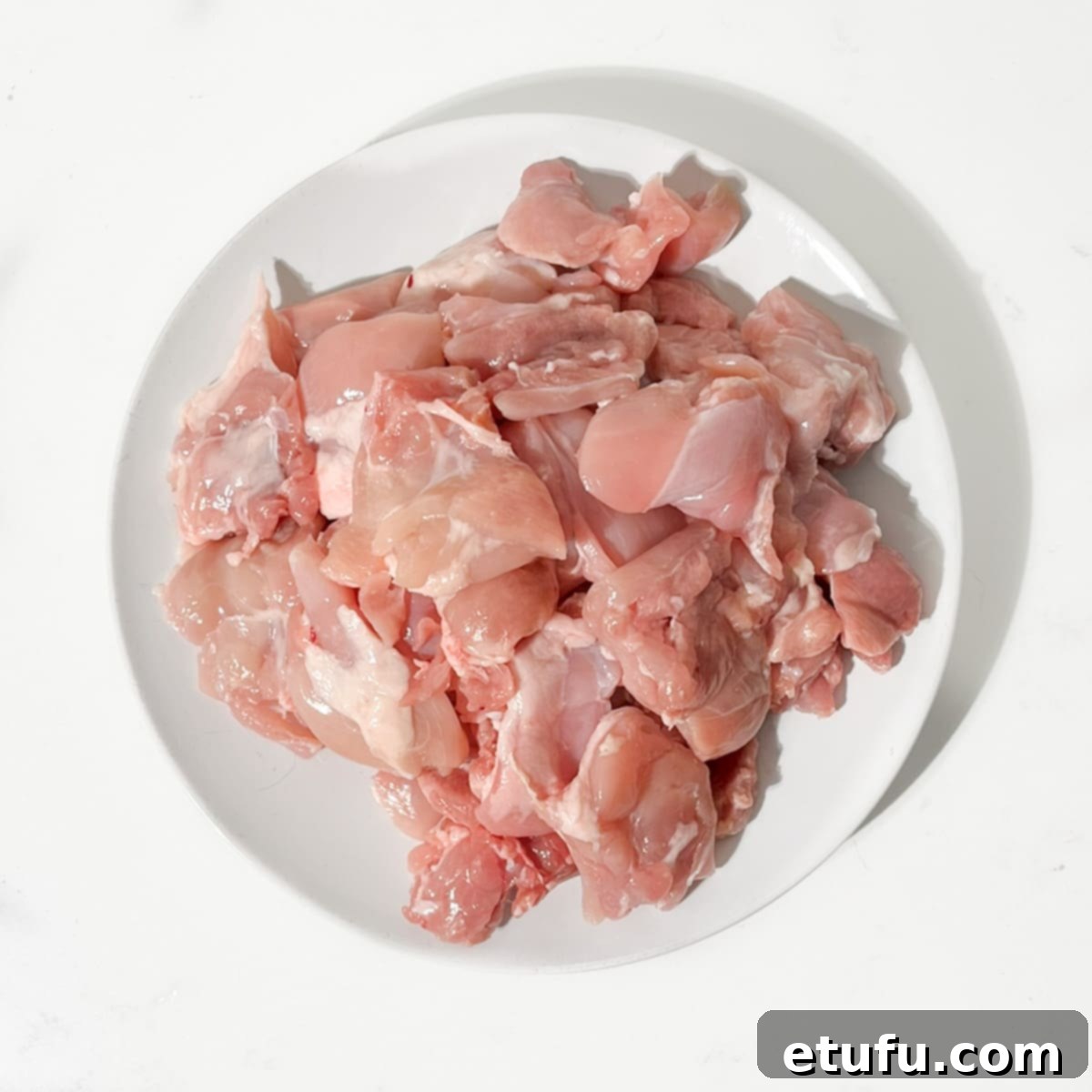
- Carefully slice your skinless, boneless chicken thighs into sizable, generous chunks. Aim for pieces that are roughly quartered, depending on the initial size of your thighs. This ensures the chicken remains juicy and tender throughout the cooking process and holds up well in the rich sauce.

- Add the prepared chicken pieces to the marinade mixture. Using your hands or a spoon, stir diligently to ensure every single piece of chicken is thoroughly coated with the aromatic marinade. Once coated, set the bowl aside. This allows the flavors to penetrate the chicken while you prepare the sauce. For optimal flavor, you can marinate for at least 30 minutes, or even overnight in the refrigerator.
Phase 2: The Double Onion Preparation
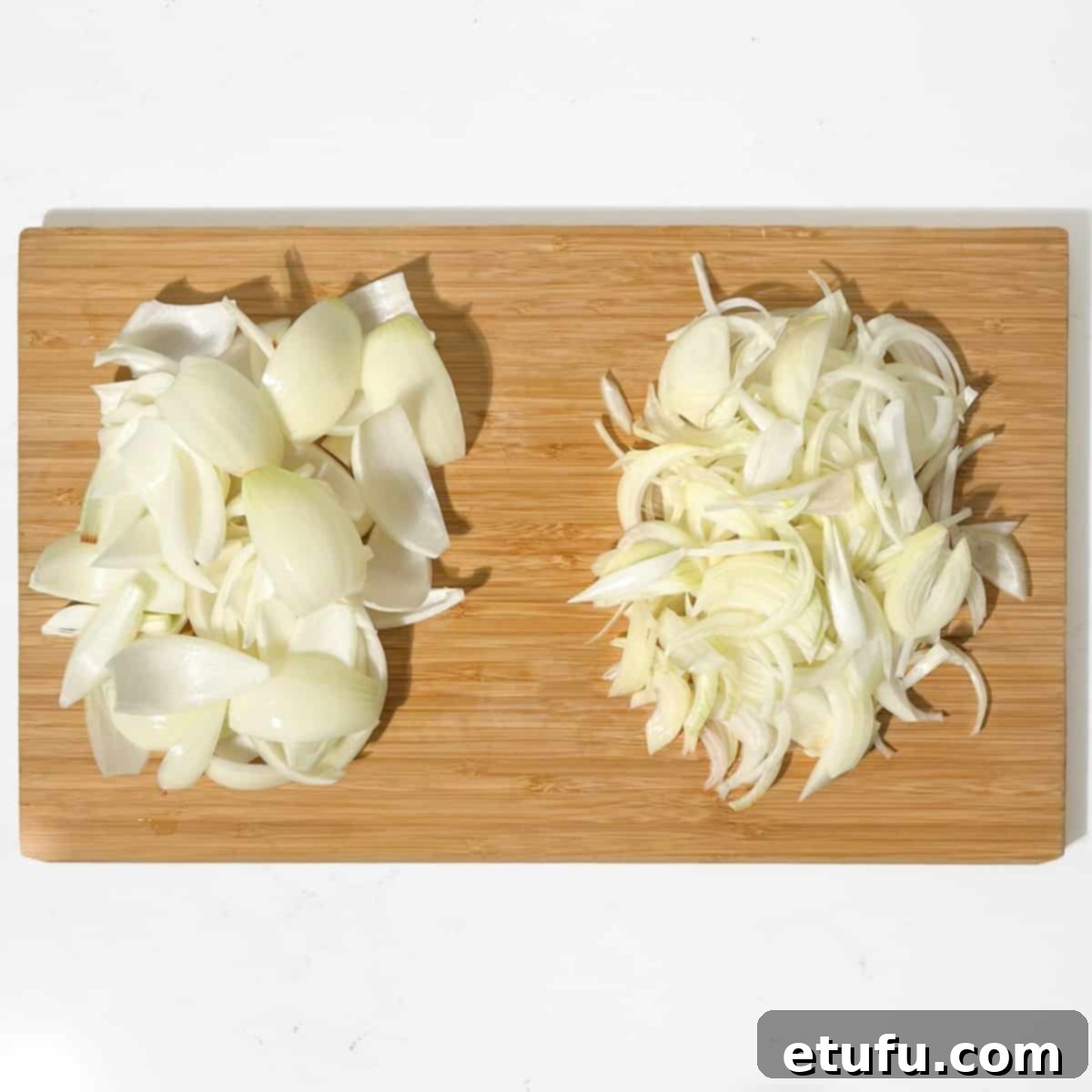
- Begin by peeling all three large onions. Take one and a half of these onions and carefully slice them into large, distinct ‘petals’. To do this, simply halve each onion, then cut each half into three segments, angling your cuts so they meet towards the center. Gently separate these segments into individual petals. The remaining one and a half onions should be thinly sliced into simple rounds or half-moons. Keep these thinly sliced onions separate, as they will be used for the curry sauce base.
Phase 3: Sautéing the Onion Petals for Texture and Char
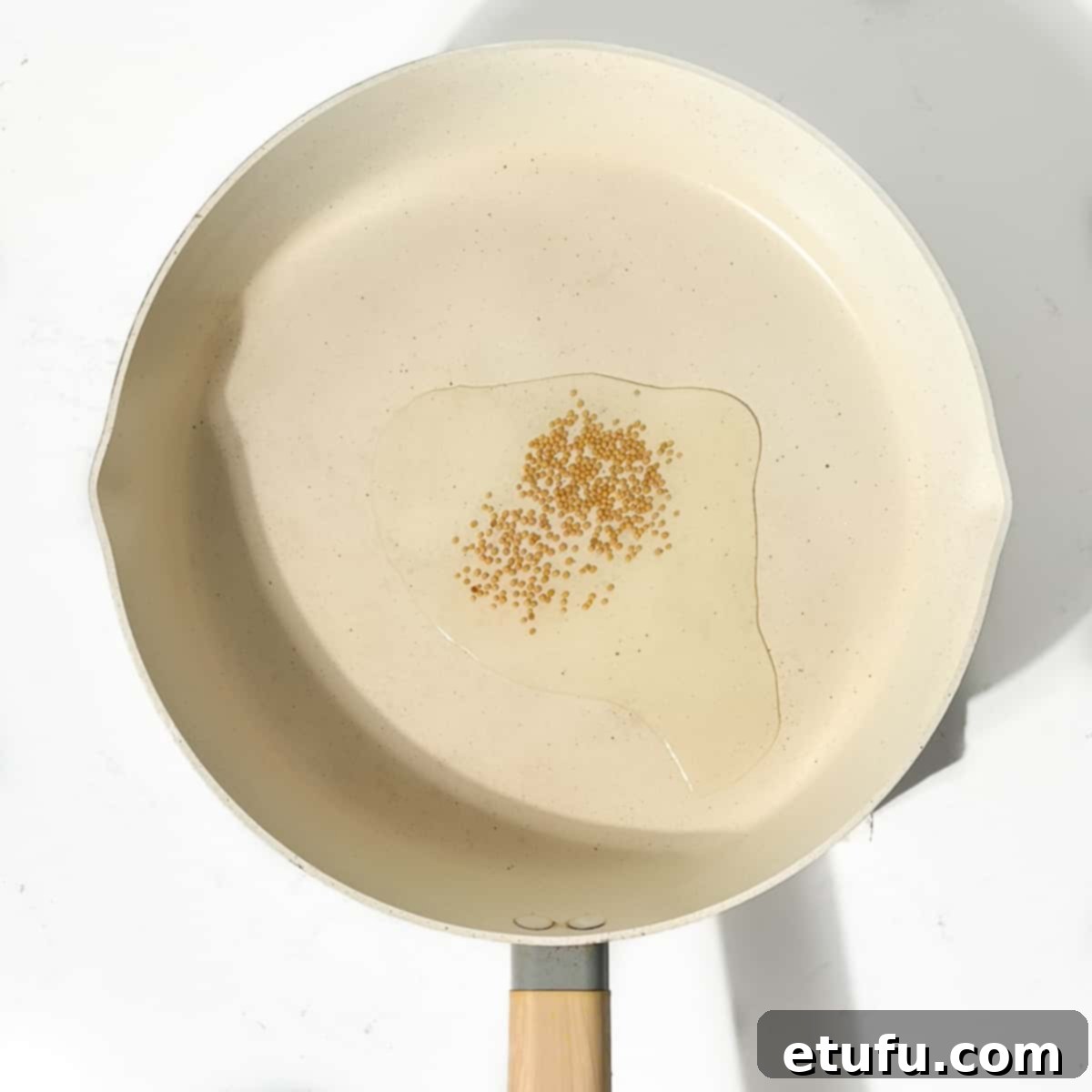
- Heat one tablespoon of oil in a large, sturdy frying pan over medium-high heat. Once the oil is shimmering, add the mustard seeds. Allow them to sizzle and pop for a few seconds; this process, known as tempering, releases their intense, pungent aroma and flavor.

- Immediately add the prepared onion petals to the pan. Sauté them vigorously, stirring occasionally, until they begin to soften and develop beautiful charred edges. This charring is essential, as it imparts a unique smoky sweetness and a desirable textural contrast to the final dish.

- Initially, try to avoid moving the onion petals around too much. Allowing them to rest on the hot pan will help them develop those desirable charred spots. This charring and softening process should take approximately 3 minutes. Once done, remove the onion petals from the pan and set them aside. They will be added back into the curry later.
Phase 4: Crafting the Rich Curry Sauce Base
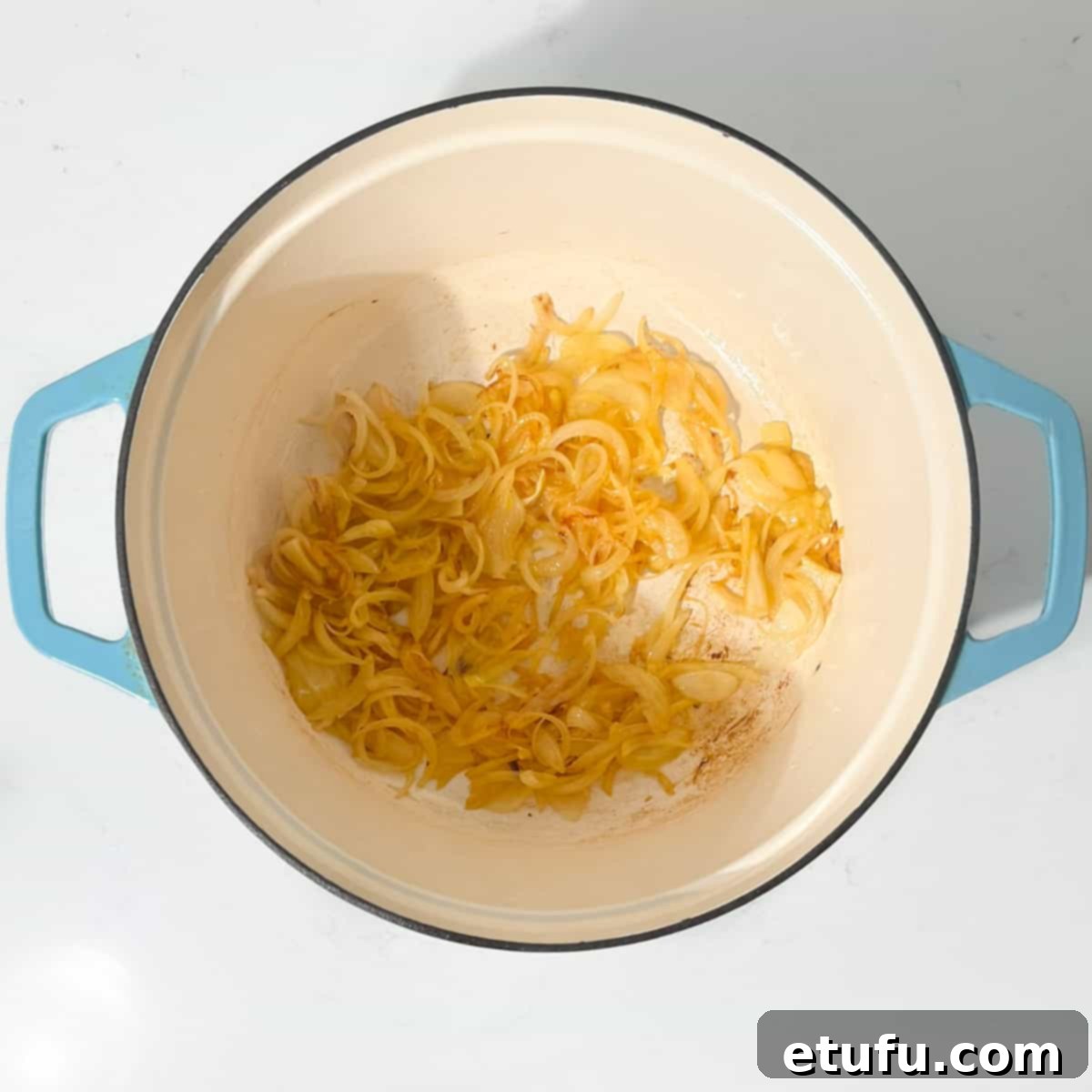
- In the same (unwashed) large, heavy-based saucepan or a deep frying pan, heat another tablespoon of oil over medium heat.
- Add the thinly sliced onions (the second batch) to the hot oil, along with a generous pinch of salt. Reduce the heat to its lowest setting. Now, patience is key: allow the onions to slowly caramelize and soften for approximately 12 minutes, stirring frequently to ensure even cooking. The goal is a deep golden-brown color, indicating rich sweetness, not burnt edges. If the onions begin to stick to the bottom of the pan, add a small splash of water or chicken broth to deglaze and prevent burning.
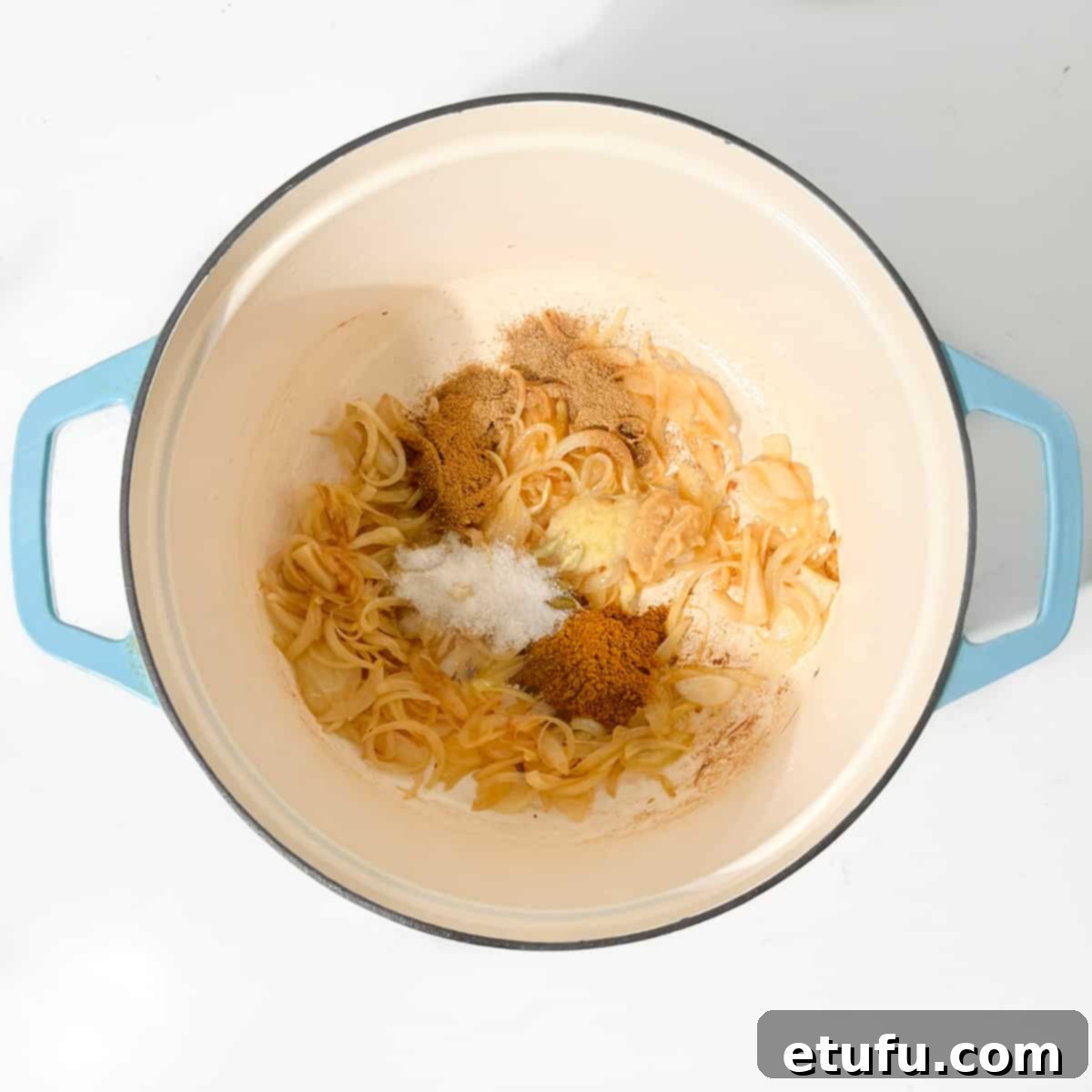
- Once the onions are beautifully caramelized, add the garlic paste, ginger paste, ground coriander, ground cumin, curry powder (mild or hot), the optional chilli powder, and the whole cardamom pods. Sauté this aromatic mixture with the onions for a further 1 minute over medium heat. Stir constantly to prevent the spices from burning, allowing their fragrant oils to release.
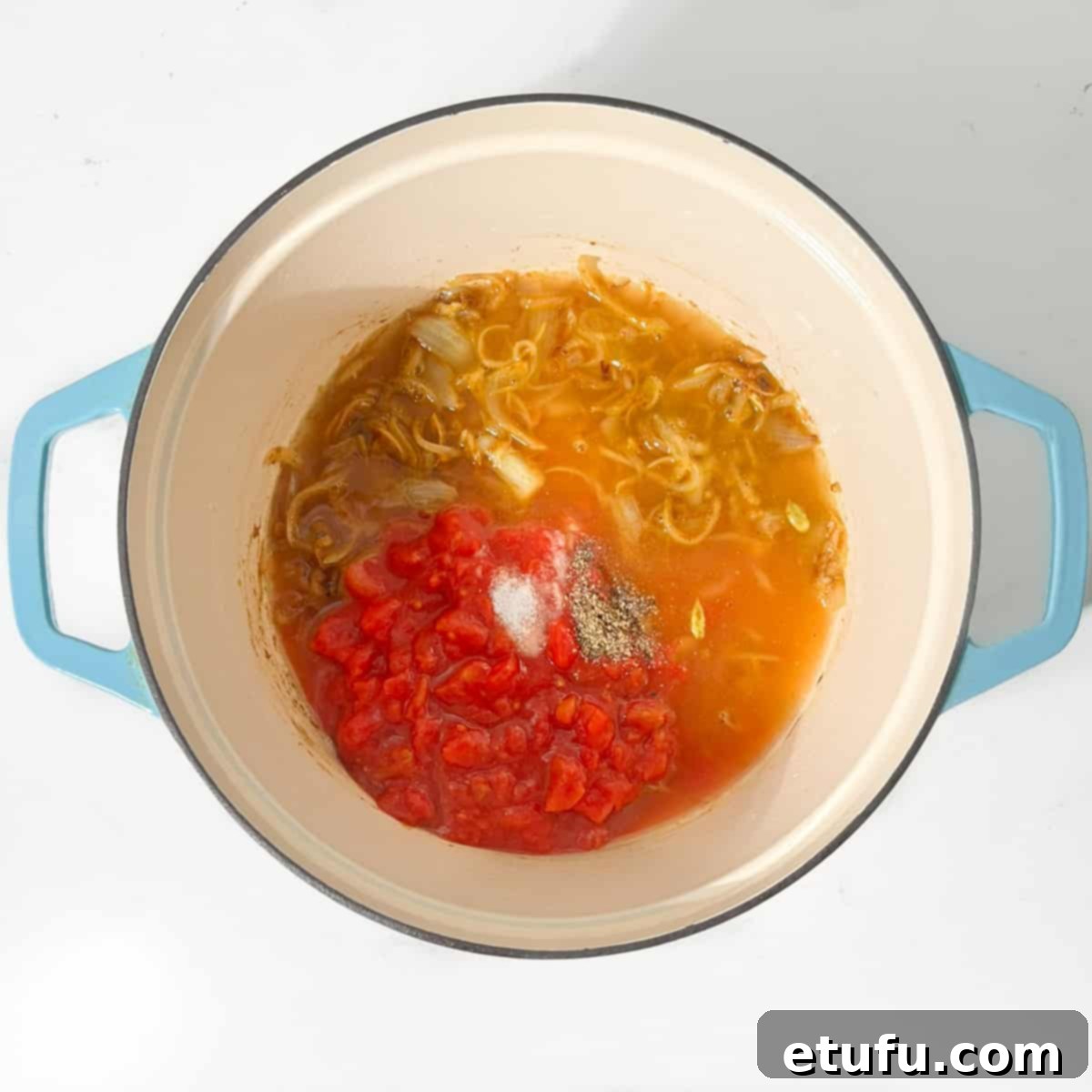
- Next, pour in the chopped tomatoes, chicken stock, sugar, and season generously with salt and black pepper to taste. Stir everything together until well combined.
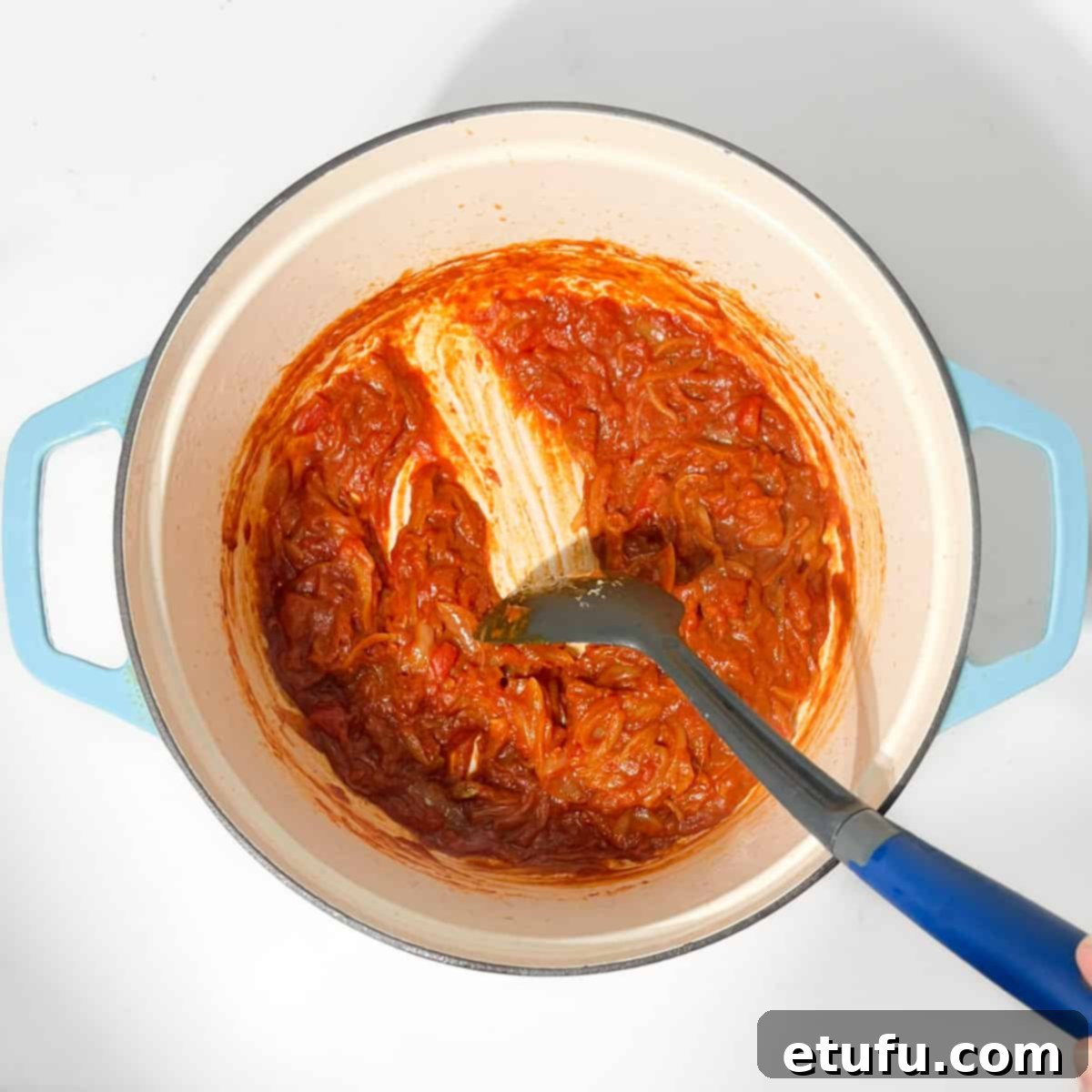
- Increase the heat to medium and bring the sauce to a gentle simmer.
- Once simmering, reduce the heat to the lowest setting. Allow the sauce to simmer gently for 18-20 minutes, stirring frequently, until it has significantly reduced and thickened to a rich consistency. For the last 5 minutes, ensure you stir continuously to prevent any sticking or burning at the bottom of the pan. This reduction is key to concentrating the flavors.

- Carefully transfer the reduced sauce to a heatproof jug or bowl. Using a stick blender, blitz the sauce until it is wonderfully smooth, breaking up any remaining large chunks of onion or tomato. Alternatively, you can achieve the same smooth consistency using a food processor for this step. Set the silky-smooth sauce aside.
Phase 5: Bringing It All Together to Form the Curry
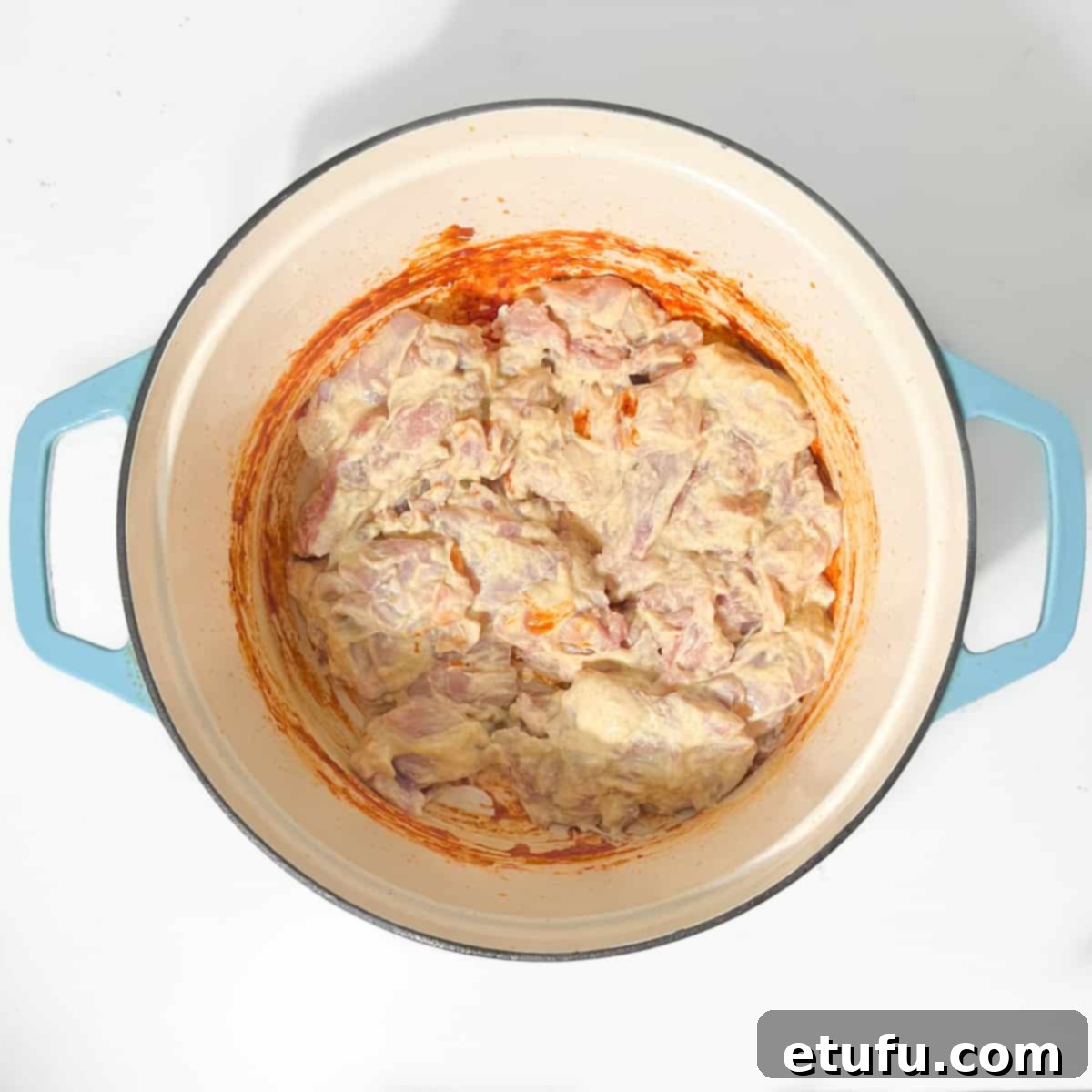
- Return to the same saucepan (no need to wash it, as the leftover flavor will only enhance the dish). Turn the heat up to high and carefully add the marinated chicken along with all the marinade mixture.
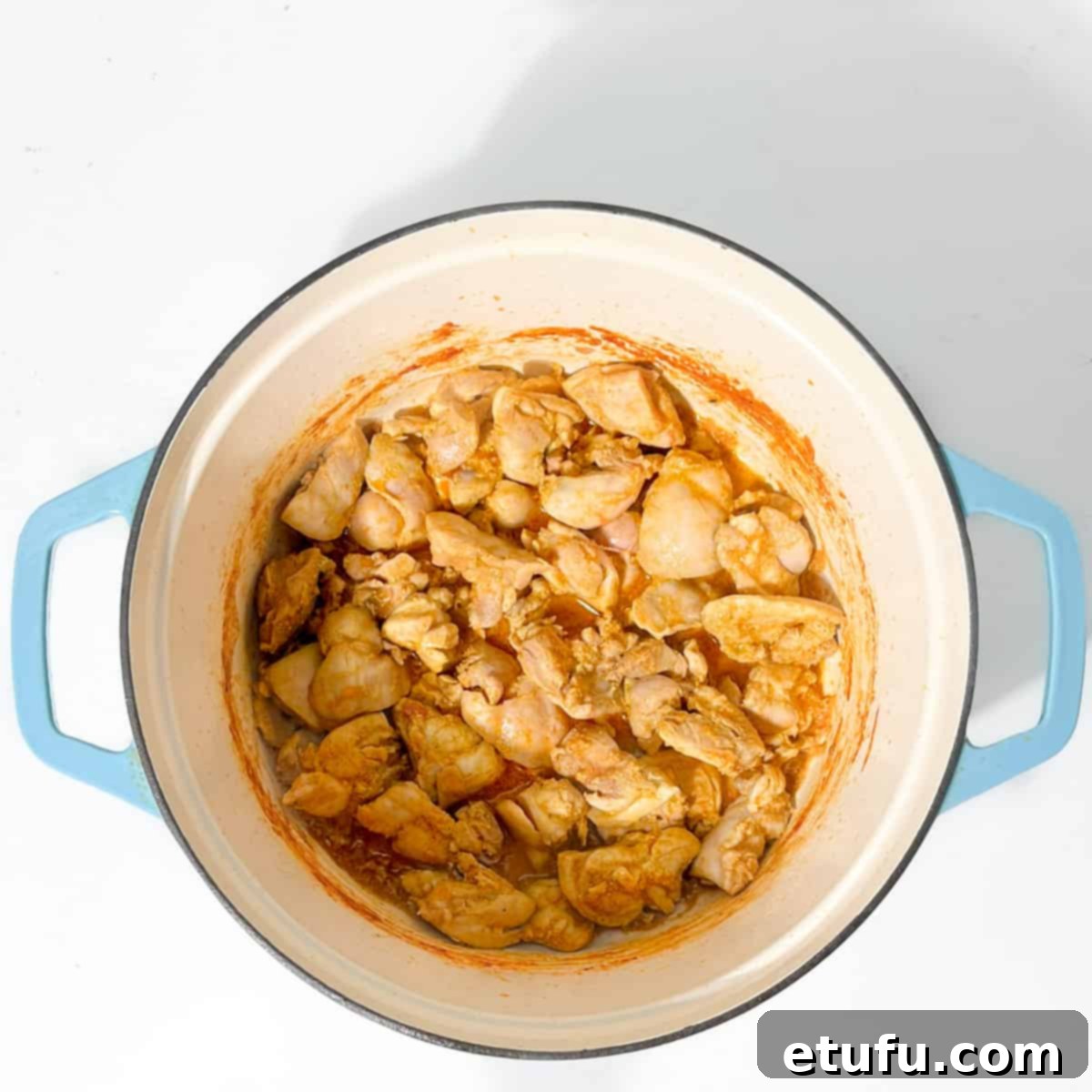
- Cook the chicken for approximately 5 minutes, stirring frequently, until it is beautifully browned on all sides and has lost most of its pinkness. This crucial step not only adds another layer of flavor but also helps to seal in the chicken’s juices, ensuring it remains tender.
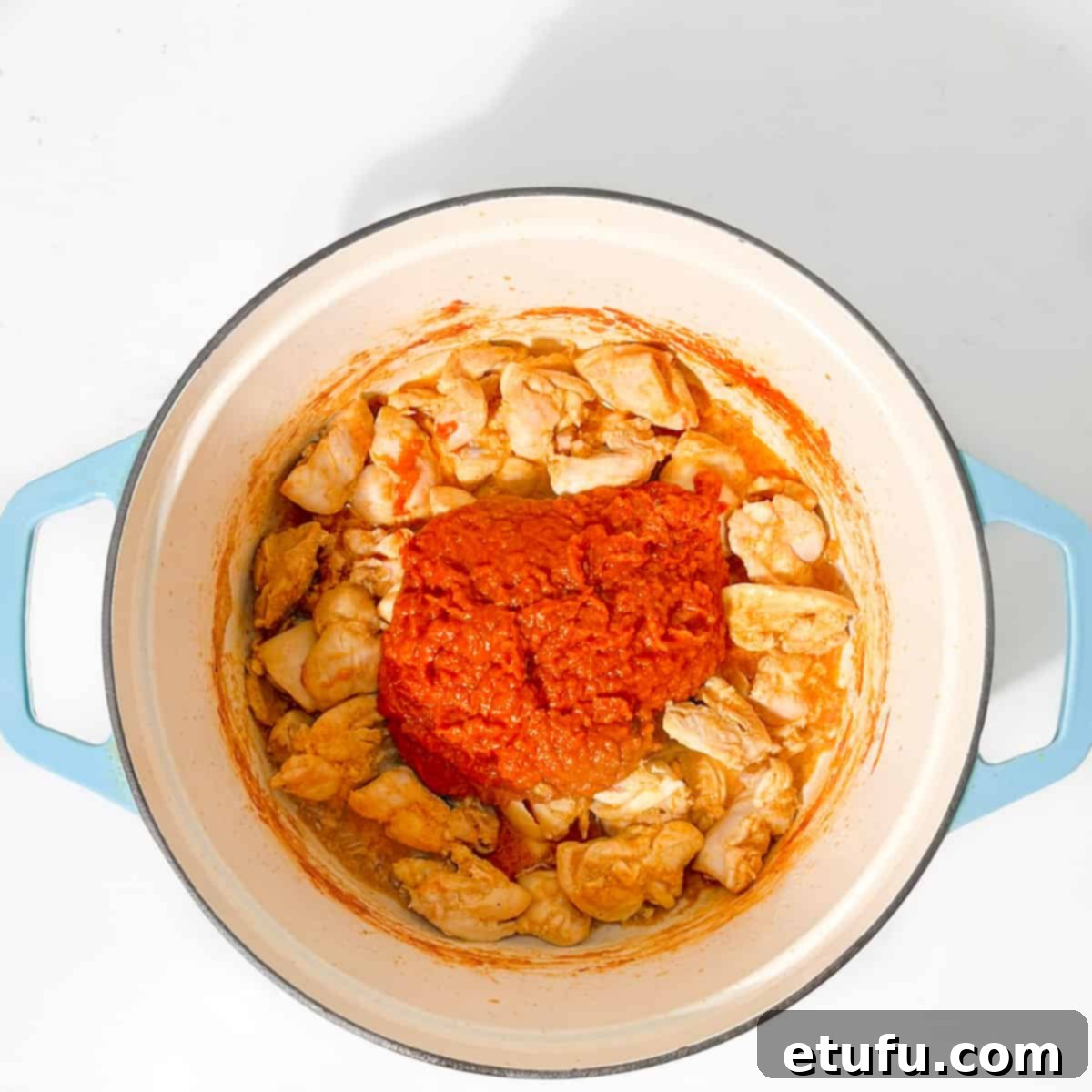
- Reduce the heat to medium. Pour the previously prepared, smooth curry sauce over the browned chicken. Stir thoroughly to ensure the chicken pieces are completely coated in the rich, fragrant sauce. Place the lid on tightly and allow the curry to cook for another 10-12 minutes, or until the chicken is cooked through and fork-tender. Remember to stir halfway through and gently scrape the bottom of the pan to prevent any sticking.

- Now, introduce the hero ingredient: add the charred onion petals that you set aside earlier. Stir them into the curry and heat through for just 2 minutes. This brief cooking time ensures they are warmed but still retain their distinctive texture and smoky flavor. If you wish, you can reserve a few petals to artfully garnish the curry before serving.
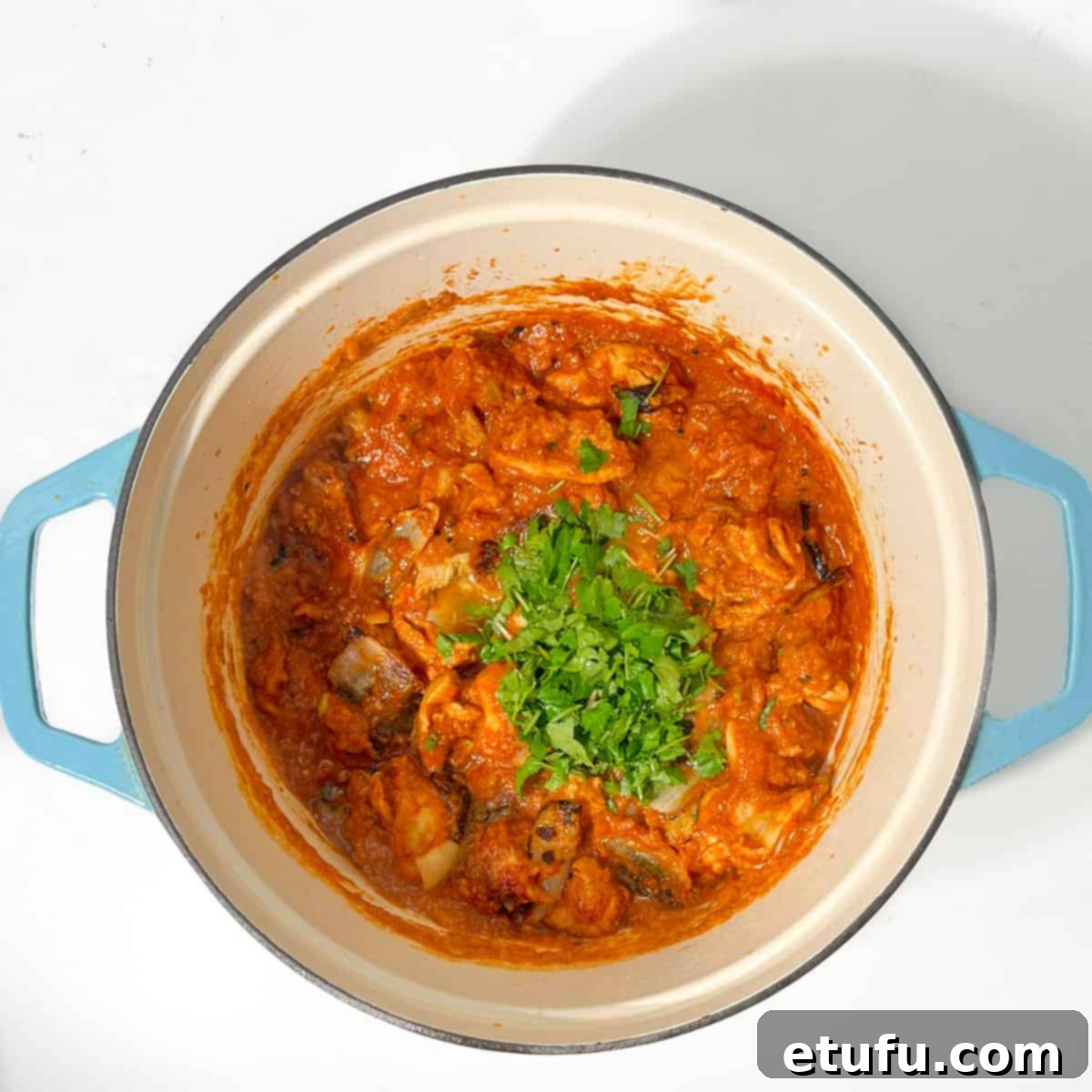
- Before the final touches, perform a taste test. Adjust the seasoning as needed, adding more salt and pepper if you feel it requires a little extra punch to bring out the full depth of flavors.
- Finally, stir in the generous handful of freshly chopped coriander. Squeeze the juice from the remaining half lemon over the curry – this bright burst of acidity will perfectly balance the rich flavors. Give it one last gentle stir and serve immediately!
Creative Variations to Elevate Your Dopiaza
Dopiaza is a wonderfully adaptable dish, offering numerous avenues for culinary creativity. Feel free to experiment with these variations to tailor the curry to your taste and available ingredients:
- Lamb Dopiaza: For a richer, more robust flavor profile, replace the chicken with tender pieces of lamb. Lamb will require a longer simmering time to become fork-tender, typically around 45-60 minutes, but the resulting depth of flavor is truly remarkable.
- Vegetarian Delight: Transform this into a delicious vegetarian version by swapping the chicken for paneer (Indian cheese), firm tofu, or even chickpeas. Paneer can be fried until golden before adding, while tofu should be pressed and cubed.
- Enhanced Heat: Beyond the suggested chilli powder, consider sautéing a couple of slit green chillies with the base onions for a deeper, more integrated heat, or simply garnish with fresh green chillies for a vibrant, immediate kick.
- Nutty Richness: Stir in some crushed nuts, such as blanched almonds or cashews, during the final simmering stage. This adds a lovely richness, a subtle nutty flavor, and a delightful textural dimension to the sauce.
- Fruity Undertones: Introduce a touch of sweetness and complexity with fruits. Diced fresh mango (when in season), dried apricots, or even a handful of dried cranberries can add a surprising and delightful layer to the curry.
- Vegetable Boost: Enhance the dish with additional vegetables for extra color, nutrition, and texture. Bell peppers (especially red or yellow), green peas, sliced mushrooms, or even spinach can be added during the simmering stage.
- Warm Spices: For an extra layer of warmth and aroma, add a small pinch of cinnamon powder, a whole cinnamon stick, or a couple of whole cloves to the sauce when you’re sautéing the other spices. These traditional Indian spices complement the Dopiaza’s profile beautifully.
- Golden Turmeric: While Dopiaza isn’t traditionally heavy on turmeric, a small pinch of ground turmeric can be added to the sauce along with the other spices. This will impart a beautiful golden hue to your curry.
- Tomato Paste for Depth: If you desire an even more concentrated tomato flavor and thicker sauce, consider swapping half of the chopped tomatoes for the same quantity of good quality tomato puree or paste.
- Garam Masala Finish: For an authentic flourish, sprinkle a pinch of freshly ground garam masala over the final dish just before serving. This blend of roasted spices adds a fragrant, warm finish without overpowering the other flavors.
- Crispy Onion Topping: For an ultimate onion experience, top your Dopiaza with extra crispy fried onions (either homemade or store-bought) for an irresistible crunch and savory depth.
Perfect Pairings: What to Serve with Chicken Dopiaza
A delicious Chicken Dopiaza deserves equally delectable accompaniments to complete the meal. Here are some ideal serving suggestions to elevate your epicurean adventure:
- Rice: The classic pairing! Serve your Dopiaza over fluffy coconut rice for a subtle sweetness that complements the curry, aromatic pilau rice, or simply perfectly cooked plain basmati rice to let the curry shine.
- Naan Bread: For optimal sauce absorption and a truly authentic experience, complement your curry with warm, soft homemade naan bread. Peshwari naan, with its sweet filling, offers a delightful contrast.
- Flatbreads & Chapatis: Alternatively, quick and easy homemade flatbreads or traditional chapatis add a delightful chewiness and are perfect for scooping up every last drop of the rich sauce.
- Poppadoms & Dips: Complete the experience with crispy poppadoms on the side. These crunchy delights are perfect for dipping into an array of accompanying sauces, such as mango chutney, raita (yogurt dip), or a spicy chili sauce.
- Fresh Salad: A simple side salad, perhaps with sliced cucumbers, tomatoes, and red onions, can provide a refreshing counterpoint to the richness of the curry.
- Raita: A cooling cucumber or mint raita (yogurt dip) is always a welcome addition, providing a creamy, soothing balance to the spices.
Storage, Reheating, and Freezing Your Chicken Dopiaza
Making a batch of Dopiaza is often even better for leftovers, as the flavors tend to deepen and meld beautifully overnight. Here’s how to properly store, reheat, and freeze your delicious homemade curry:
Storage
To safely store your Chicken Dopiaza, ensure it cools down completely to room temperature first. Once cool, transfer the curry into an airtight container. This helps to prevent bacterial growth and keeps your food fresh. Properly stored, your Chicken Dopiaza can be kept in the refrigerator for up to 3-4 days. This makes it an excellent option for meal prepping throughout the week.
Reheating
When you’re ready to enjoy your Dopiaza again, you have two convenient options: the stovetop or the microwave.
- On the Stovetop: Transfer the desired portion of curry to a saucepan. Gently warm it over low to medium heat, stirring occasionally. This method allows for even reheating and helps maintain the curry’s original consistency and texture. If the sauce appears too thick, you can add a small splash of water or chicken broth to reach your preferred consistency.
- In the Microwave: Place the curry in a microwave-safe dish. Heat it in short intervals, typically 1-2 minutes at a time, stirring well in between each interval. Continue until the curry is piping hot throughout. Adding a splash of water or broth before reheating can be beneficial to prevent the curry from drying out, especially if it has thickened in the fridge.
Always ensure the curry is thoroughly heated through before serving for food safety.
Freezing
Dopiaza freezes wonderfully, allowing you to enjoy this delicious curry even months later. To freeze, let the curry cool completely to room temperature. Then, transfer it to a freezer-safe container or heavy-duty freezer bags. Make sure the container is airtight to prevent freezer burn, which can affect texture and flavor.
Frozen Chicken Dopiaza can be stored in the freezer for up to 2-3 months without significant loss of quality. When you’re ready to enjoy it, thaw the curry in the refrigerator overnight. Once thawed, you can reheat it using either the stovetop or microwave methods mentioned above. While the flavors will remain intact and often even deepen, be aware that freezing may slightly alter the texture of the onions, making them a little softer than when freshly made. This is a minor change and won’t detract from the overall enjoyment of the dish.
Discover More Delicious Curry Recipes
If you loved making this Chicken Dopiaza, explore our other exquisite curry recipes to continue your culinary journey:
- Chicken Handi Curry
- Nepalese Chicken Curry
- Oven-baked Pasanda Curry
- Aromatic Beef Curry with Coconut Milk
- Curried Mince (for Vetkoek)
- Curry Noodle Salad
- Chicken Karahi
Chicken Dopiaza (Do Pyaza) Recipe

Chicken Dopiaza (Do Pyaza)
Is Dopiaza your favorite go-to Friday night curry at your local British Indian Restaurant (BIR)? Are you ready to bring that authentic restaurant experience home? This Chicken Dopiaza recipe brings the essence of this hugely popular curry straight to your kitchen, step-by-step, allowing you to create a dish rich in flavor and texture.
Rated 5 out of 5 stars by 36 users.
Print Recipe
Course: Main Course
Cuisine: Indian
Cook Time: 1 hour 5 minutes
Total Time: 1 hour 5 minutes
Servings: 4 servings
Calories: 505 kcal
Author: Maretha Corbett
Equipment
- 1 large heavy-based saucepan with lid, or a large, deep frying pan with a lid
Ingredients
For the chicken marinade
- ½ teaspoon ground coriander
- ½ teaspoon ground cumin
- 1 teaspoon mild curry powder (or hot curry powder, depending on preference)
- 120 millilitre (½ US cup) plain full-fat yoghurt
- ½ lemon, juice of
- 1 teaspoon garlic paste
- 1 teaspoon ginger paste
- 1 kilogram (2.2 lb) skinless boneless chicken thighs, diced in large chunks (chicken breast can be substituted, though thighs are recommended for juiciness)
For the onion petals
- 1 tablespoon oil for frying
- ½ teaspoon mustard seeds
- 1½ large onions (brown or red onion, sliced into petals)
For the sauce
- 1 tablespoon oil for frying
- 1½ large onions (brown or red onion, thinly sliced)
- Good pinch of salt
- 1 teaspoon garlic paste
- 1 teaspoon ginger paste
- 1 teaspoon ground coriander
- 1 teaspoon ground cumin
- 1 tablespoon mild curry powder (or hot curry powder)
- ½ teaspoon chilli powder (optional, or to taste; if using hot curry powder, taste first)
- 4 cardamom pods
- 400 grams (14 oz) tin of chopped tomatoes
- 300 millilitre chicken stock (made with one stock cube)
- 2 teaspoons sugar
- ½-1 teaspoons salt (to taste)
- Black pepper to taste
Final touches
- Large handful of coriander, chopped
- ½ lemon, juice of
- Salt and pepper to taste
Instructions
Marinate the chicken
- Combine all the marinade ingredients in a large bowl, excluding the chicken, and mix thoroughly until well combined.
- Slice the chicken thighs into sizable chunks. Quartering each thigh usually works perfectly, depending on its size, ensuring tender and juicy pieces.
- Add the sliced chicken to the marinade and stir well to ensure every piece is thoroughly coated. Set aside to marinate for at least 30 minutes, or longer in the refrigerator.
Prep the onions
- Peel all three onions. Slice one and a half onions into large ‘petals’. Thinly slice the remaining one and a half onions and set this batch aside for later use in the sauce. (See Note 1 for how to slice onions into petals.)
Sauté the onion petals
- Heat 1 tablespoon of oil over medium-high heat in a large frying pan. Add the mustard seeds and let them sizzle and pop for a few seconds.
- Immediately add the onion petals and sauté them until they achieve some charred areas and begin to soften.
- Initially, avoid moving them around too much to allow for proper charring. This process will take about 3 minutes. Remove the petals from the pan and set them aside.
Make the curry sauce
- Heat 1 tablespoon of oil in a large, heavy-based saucepan or a deep frying pan over medium heat.
- Add the thinly sliced onions (from the second batch) and a generous pinch of salt. Reduce the heat to its lowest setting and let the onions caramelize and soften for approximately 12 minutes, stirring frequently. If they start to stick, add a small splash of water. Aim for a rich golden-brown color, not burnt.
- Add the garlic paste, ginger paste, ground coriander, ground cumin, curry powder, optional chilli powder, and whole cardamom pods. Sauté this mixture with the caramelized onions for 1 minute over medium heat, stirring constantly.
- Next, add the chopped tomatoes, chicken stock, sugar, and season with salt and black pepper to taste.
- Over medium heat, bring the sauce to a gentle simmer.
- Once simmering, reduce the heat to the lowest setting and let it cook gently for 18-20 minutes. Stir frequently until the sauce is reduced and thickened. Stir continuously for the last 5 minutes to prevent sticking or burning.
- Transfer the sauce to a jug or bowl. Use a stick blender to blend the sauce until it is smooth, breaking up any large chunks. Alternatively, a food processor can be used. Set the smooth sauce aside.
Bringing it all together
- In the same unwashed saucepan, turn the heat to high and add the marinated chicken along with all the remaining marinade.
- Cook for 5 minutes until the chicken is browned and has lost most of its pinkness. This step helps to seal the chicken’s juices and adds depth of flavor.
- Next, turn the heat to medium and add the prepared curry sauce to the chicken. Thoroughly combine the sauce with the chicken pieces. Place the lid on tightly and cook for 10-12 minutes until the chicken is fully cooked through and tender. Stir halfway through, ensuring to scrape the bottom of the pan to prevent any sticking.
- Add the charred onion petals that you set aside earlier. Stir them into the curry and heat through for 2 minutes. (Optionally, set aside a few petals to garnish the curry later.)
- Check the seasoning and add more salt and pepper if you feel the curry needs it to balance the flavors.
- Lastly, stir in the generous handful of freshly chopped coriander and squeeze the juice from the remaining half lemon over the curry. Stir through and serve immediately!
Notes
Note 1: To slice an onion into petals, simply halve each onion and then cut each half into three segments, angling the cuts so they meet towards the center. Gently separate the petals from each other. For a visual demonstration, you can search for “how to slice an onion into petals” online.
**Nutritional Data Disclaimer**
Please keep in mind that the nutritional information provided below is an estimate calculated by a third party, and we cannot guarantee its complete accuracy. We strive to provide the most precise information possible, but we do not take responsibility for any errors that may be present. Furthermore, the nutritional value of this recipe may vary depending on the exact brands and specific products used in your preparation. For personalized advice on your dietary needs and health, we strongly recommend consulting with a qualified healthcare professional or a registered dietitian.
Nutrition
Calories: 505 kcal | Carbohydrates: 26g | Protein: 60g | Fat: 18g | Saturated Fat: 4g | Polyunsaturated Fat: 4g | Monounsaturated Fat: 8g | Trans Fat: 0.03g | Cholesterol: 181mg | Sodium: 751mg | Potassium: 1241mg | Fiber: 6g | Sugar: 11g | Vitamin A: 416IU | Vitamin C: 37mg | Calcium: 165mg | Iron: 6mg
For comprehensive food safety advice, including detailed guidance on food allergies, please refer to official food safety resources.
